Motorola Droid RAZR Review - A Better Clad Bionic
by Brian Klug on December 16, 2011 2:01 AM EST- Posted in
- Smartphones
- Droid
- LTE
- 4G
- Motorola
- Android
- Mobile
- Droid RAZR
- motorola droid RAZR
Battery Life
I still think that when we’re reviewing a 4G LTE device that battery life is the main concern, and with a sealed internal battery this is an even more relevant point than it would be otherwise. I started the Bionic review out with a look at battery life first, and think the same approach makes sense for the RAZR. As I mentioned before, the RAZR has a 6.7 Whr internal battery which makes use of Motorola’s new higher voltage Li-Ion chemistry, just like we saw in the Bionic.
Motorola also sent us all the goodies to go along with the RAZR, including the Lapdock 100, car windshield mount, VGA adapter, and an extra external 6.9 Whr battery. More on those accessories in a moment, for now let's just talk about the battery.
Since the battery for the RAZR is sealed inside, there’s no way to go the traditional extended battery route, and thus this external battery which connects using microUSB is the only viable option to extend your electron tank. The external battery charges using a microUSB port on its side and can charge up to two devices at the same time.
One using the microUSB connector on a rubberized cable that folds into the opposite side, the other using the female USB type A connector at the top. I used the external charger to juice up the RAZR and another device at the same time to much success. Of course, using a big external battery to simultaneously charge a battery and power the RAZR incurs some overhead.
To measure how good the RAZR is at sipping juice, we turned to our standard suite of battery life tests. The first loads through a dozen or so pages over cellular data and WiFi with the display constantly on and set to a brightness of 200 nits using the stock browser.

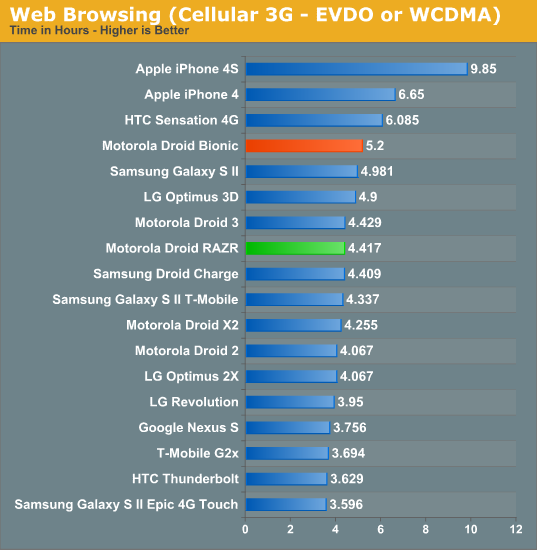
In the cellular browsing department, the RAZR unsurprisingly performs very close to the Bionic, but comes in just behind in spite of having a slightly larger battery. It’s pretty easy to point out the sources of increased battery drain on the RAZR versus Bionic, and that’s both inclusion of AMOLED (virtually all the webpages in our testing suite have white backgrounds), and a higher CPU clock, though admittedly most of the time the CPU is in an idle state. The other parts of the equation again remain the same - the RAZR has the same cellular basebands and a similar family PMIC (power management IC).
Using the external battery gives you another 2.5 hours of charge in our LTE test, which isn’t a doubling, but still a respectable boost. As predicted, you end up losing some of that charge on the external battery to overhead, but it isn’t dramatic. I didn’t measure how much of a gain using the external battery on EVDO nets you, but you can safely bet the same 1.83 multiplier applies.
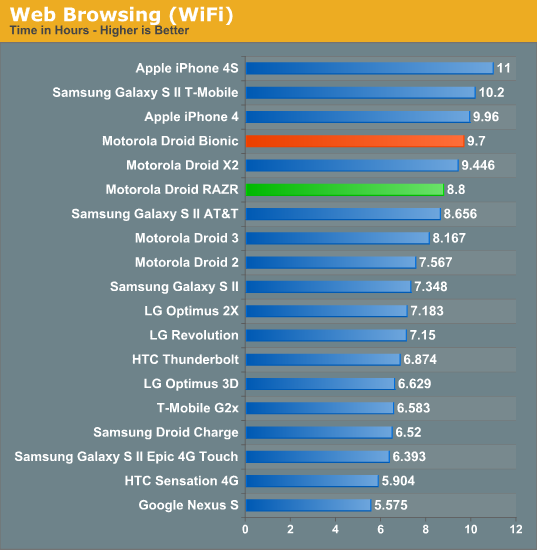
This trend where the RAZR lags the Bionic in our battery life testing carries on to the WiFi web browsing test as well - the two include the same TI WL1285 WLAN combo chip.
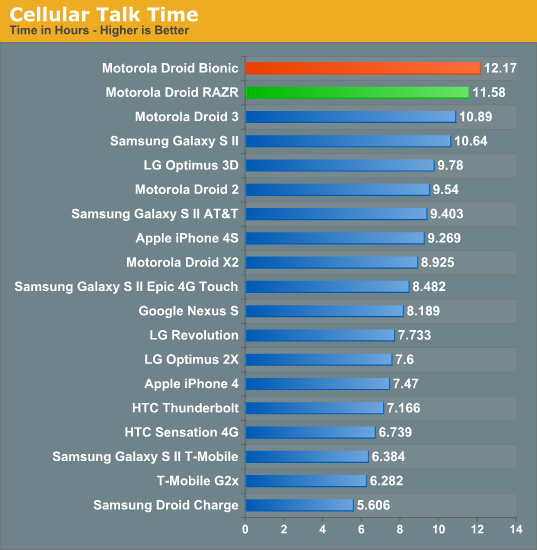
Call testing time likewise puts the RAZR just behind the Bionic. As a reminder, calls on Verizon still happen over 1x on the MDM6600.
I’m starting to put more stock in our WiFi hotspot battery life test, which has four of our normal page loading tabs open and a 128 kbps MP3 streaming radio instance from smoothbeats.com going. This keeps the baseband and WiFi stacks up and also relies on the CPU for routing network traffic through a NAT, and the display is off.
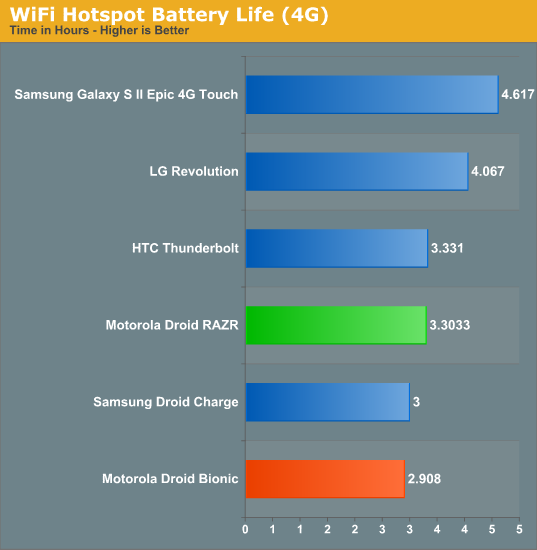
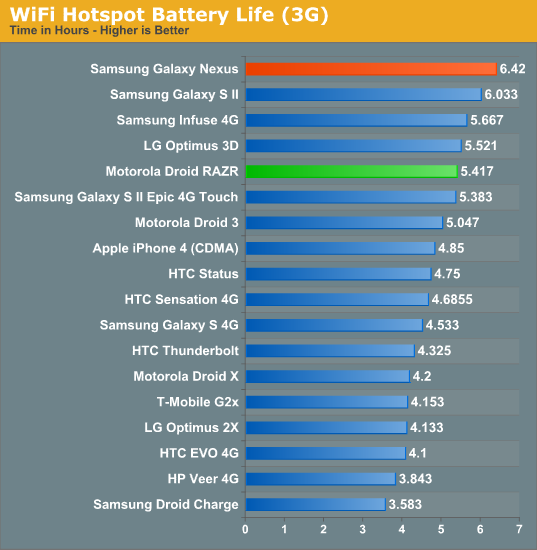
Here the RAZR surprisingly ousts the Bionic (despite testing being done in the exact same location and signal characteristics) by a little over a half hour.
So in the battery department there isn’t much to talk about with respect to the RAZR except to note that it’s very comparable to the Bionic owing to - again - being based on essentially the same hardware platform. The difference we do see is largely a result of adding a Super AMOLED Advanced display and higher peak CPU clock.
If you’re not near a charger or unwilling to go for the external battery, our guidance remains much the same as it did when we first started looking closely at 4G LTE handsets - wait for 28nm SoCs and basebands in 2012. That said, it’s absolutely possible to make it through a day with the internal battery, it just depends on what your daily use patterns are.



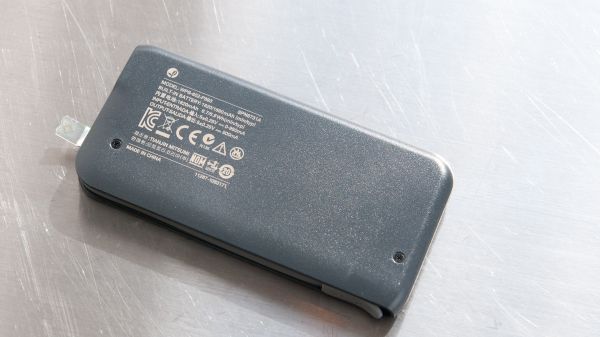














76 Comments
View All Comments
kishorshack - Friday, December 16, 2011 - link
That is an awesome phone, a request from all of usDo review it. The interesting part here would be running ICS on it :D
dj christian - Thursday, December 22, 2011 - link
Hope you were ironic. Well i've read alot of N9 reviews already but it would be nice if Anand would do one, just part from the usual Android and iOS sphere of lately.Araemo - Friday, December 16, 2011 - link
You mention you tested wifi hotspot with encryption off on this phone.. is that possibly why it bested the droid bionic's wifi hotspot battery life by so much? AES encryption could be a not-insignificant amount of the power draw when operating a secured wifi hotspot.IKeelU - Friday, December 16, 2011 - link
I think the phone would be way nicer without an edge that sticks out. It makes it look dated already, but there's probably a structural reason to have it there (or something).Also wtf is Apple doing to make 3g browsing last so damn long?!
PeteH - Sunday, December 18, 2011 - link
It must have something to do with that giant A5, because the iPhone 4 doesn't have nearly the same benefit.mr_thomas - Friday, December 16, 2011 - link
If you are going to put in iPhone comparisons in the benchmarks, etc., please do it across the board. It isn't helpful to see it in only a few places.introiboad - Tuesday, December 20, 2011 - link
I think they avoid it in browser benchmarks because Gingerbread doesn't support multithreaded rendering, and the comparison would be unfair. Don't take my word for it though.doobydoo - Tuesday, January 17, 2012 - link
There are only certain benchmarks which can be carried out on both Android and iOS, and on particular handsets. Everywhere where the benchmark could be carried out, they included it, which is as informative as they can be.RavnosCC - Friday, December 16, 2011 - link
Where's the comparison? HTC's Rezound has arguably much better hardware than the RAZR, and yet it's left out :(Plester - Friday, December 16, 2011 - link
I find the really big bezel and angled corners results in a down right odd and ugly looking phone, but taste is subjective...